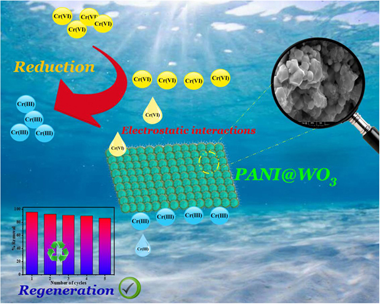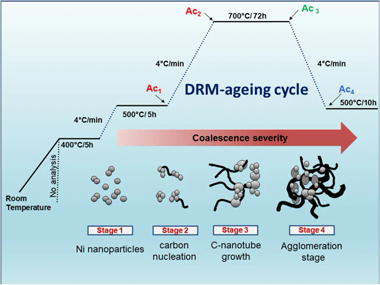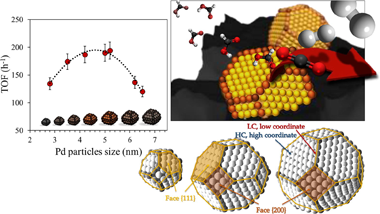Scientific Papers in SCI
2021
2021
Fotocatálisis Heterogénea: Aplicaciones
Development of a novel PANI@WO3 hybrid composite and its application as a promising adsorbent for Cr(VI) ions removal
Abdelghani Hsinia, Yassine Naciri, Mohamed Laabd, Asmae Bouziani, J.A.Navío, F.Puga, Rabah Boukherroub, Rajae Lakhmiri, Abdallah AlbourineJournal of Environmental Chemical Engineering, 9 (2021) 105885
Show abstract ▽

In the current study, an in-situ oxidative polymerization method was used to synthesize polyaniline-coated tungsten trioxide biphasic composite (PANI@WO3). The as-developed composite material properties were elucidated using different characterization tools such as X-ray diffraction (XRD), scanning electron microscopy (SEM), energy dispersive X-ray spectroscopy (EDX), transmission electron microscopy (TEM), Fourier transform infrared spectroscopy (FTIR), N2 sorption-desorption isotherm, and X-ray photoelectron spectroscopy (XPS). The PANI@WO3 was further applied to remove hexavalent chromium (Cr(VI)) from aqueous solutions. The results demonstrated that the optimal removal efficacy was achieved at pH 2. Meanwhile, the pseudo-second-order kinetic and isotherm of the Langmuir model were fitted for Cr(VI) adsorption. Cr(VI) amount of 549.37 mg·g−1 was the maximum capacity of adsorption attained for PANI@WO3, which is significantly higher than that of existing adsorbents. From a thermodynamic point of view, the Cr(VI) adsorption process occurred spontaneously and endothermically. Importantly, PANI@WO3 still exhibited an excellent adsorption capability after five regeneration cycles, indicating the potential reusability of the PANI@WO3 composite. XPS analysis of PANI@WO3 surface after adsorption of Cr(VI) confirmed its adsorption and concomitant reduction into Cr(III) ions. The transfer of mass phenomenon, electrostatic attraction, and reduction reaction were the primary processes for Cr(VI) ions elimination. These findings revealed that the synthesized PANI@WO3 exhibited a high potential for wastewater treatment containing Cr(VI).
October, 2021 | DOI: 10.1016/j.jece.2021.105885
Materiales Coloidales
Si sputtering yield amplification: a study of the collisions cascade and species in the sputtering plasma
Cruz, J; Sangines, S; Soto-Valle; Muhl; Sierra, I; De Lucio-Morales, O; Mitrani, A; Calderon-Olvera, RM; Mendoza-Perez, R; Machorro-Mejia, RJournal of Physics D-Applied Physics, 54 (2021) 375201
Show abstract ▽
The sputtering yield amplification (SYA) is a phenomenon based on doping a sputtering target with atoms of higher atomic mass. This doping changes the depth and the direction of the collision cascade in the target surface promoting a higher ejection of target atoms. In this work, we present a new way of generating the SYA phenomenon without the need of expensive and complex deposition systems. This was accomplished by increasing the working pressure and adding small pieces of W, as dopant element, on the racetrack of a Si target. The physical phenomena necessary to promote the SYA, for our experimental parameters, were analysed in two different deposition chambers and two sizes of sputtering targets. Based on the collisions in the gas phase, a calculation on the number of W atoms returning to the racetrack area was made, considering the number of atoms deposited on the thin films, to determine their effect on the cascade of collisions. In addition, calculations with the simulation of metal transport code were developed to determine the location on the racetrack zone the returning atoms were redeposited. By using reference samples placed on the racetrack of the Si target, we found that the percentage of SYA depends on the number of dopant atoms redeposited as well as the depth distribution these atoms had in the racetrack surface.
September, 2021 | DOI: 10.1088/1361-6463/ac0c4e
Materiales Nanoestructurados y Microestructura
Pd-C Catalytic Thin Films Prepared by Magnetron Sputtering for the Decomposition of Formic Acid
Arzac, GM; Fernandez, A; Godinho, V; Hufschmidt, D; de Haro, MCJ; Medran, B; Montes, ONanomaterials, 11 (2021) 2326
Show abstract ▽
Formic acid is an advantageous liquid organic hydrogen carrier. It is relatively nontoxic and can be synthesized by the reaction of CO2 with sustainable hydrogen or by biomass decomposition. As an alternative to more widely studied powdery catalysts, supported Pd-C catalytic thin films with controlled nanostructure and compositions were newly prepared in this work by magnetron sputtering on structured supports and tested for the formic acid decomposition reaction. A two-magnetron configuration (carbon and tailored Pd-C targets) was used to achieve a reduction in Pd consumption and high catalyst surface roughness and dispersion by increasing the carbon content. Activity and durability tests were carried out for the gas phase formic acid decomposition reaction on SiC foam monoliths coated with the Pd-C films and the effects of column width, surface roughness and thermal pre-reduction time were investigated. Activity of 5.04 mol(H2)center dot g(Pd)(-1)center dot h(-1) and 92% selectivity to the dehydrogenation reaction were achieved at 300 degrees C for the catalyst with a lower column width and higher carbon content and surface roughness. It was also found that deactivation occurs when Pd is sintered due to the elimination of carbon and/or the segregation and agglomeration of Pd upon cycling. Magnetron sputtering deposition appears as a promising and scalable route for the one-step preparation of Pd-C catalytic films by overcoming the different deposition characteristics of Pd and C with an appropriate experimental design.
September, 2021 | DOI: 10.3390/nano11092326
Materiales y Procesos Catalíticos de Interés Ambiental y Energético
Examination of the Deactivation Cycle of NiAl- and NiMgAl-Hydrotalcite Derived Catalysts in the Dry Reforming of Methane
Abdelsadek, Z.; Holgado, J.P.; Halliche, D.; Caballero, A.; Cherifi, O.; Gonzalez-Cortes, S.; Masset, P.J.Catalysis Letters, 151 (2021) 2696-2715
Show abstract ▽

The importance of the dry reforming of methane (DRM) lies in its capability to upgrade two greenhouse gases (CH4 and CO2) into synthesis gas (CO and H-2), which is one of the main building block for synthesizing hydrocarbons. However, the Ni-based catalysts for DRM reaction usually have a major catalytic stability drawback. This works aims to assess the catalytic activity and stability of two Ni-based catalysts obtained from hydrotalcite (HT) precursors (i.e., NiAl-HT and NiMgAl-HT). The precursors, calcined (-c), reduced (-R) and spent samples were characterized by a series of techniques to gain insight into the influence of MgO over Ni-based catalyst in the drying reforming of methane. An in-situ ageing cycle process to speed up the deactivation of hydrotalcite-derived catalysts showed that the NiMgAl-HTc-R catalyst displayed a higher activity and resistance to coke formation (stability) than NiAl-HTc-R because of the introduction of Mg into hydrotalcite structure in the catalyst precursor. The presence of this element enhances several factors involved in the stability of Ni-based catalysts for the DRM process such as the reducibility and textural features of the catalysts, size and dispersion of Ni-0 nanoparticles and also maintains a good compromise between the acid and base properties of the solid catalysts.
September, 2021 | DOI: 10.1007/s10562-020-03513-4
Química de Superficies y Catálisis
Structure-sensitivity of formic acid dehydrogenation reaction over additive-free Pd NPs supported on activated carbon
Santos, J.L.; Megías-Sayago, C.; Ivanova, S.; Centeno, M.A.; Odriozola, J.A.Chemical Engineering Journal, 420 (2021) 127641
Show abstract ▽

In this study the size-activity dependence of palladium based catalysts in formic acid dehydrogenation reaction was investigated and evaluated. A wide range of particle sizes was considered and the catalyst series were prepared upon variation of some synthetic parameters, precursor and solvent nature in particular. Synthesis method variations affect significantly Pd particle size and results in diverse activity toward hydrogen production. An optimal size was observed and explained by the diverse proportion of low and high coordinated Pd states available for different samples within the series. The evaluation of particles much bigger than 6 nm changes importantly the fraction of high and low coordination atoms and allows the clear confirmation of the importance of the presence of low coordination atoms on the surface of catalyst.
September, 2021 | DOI: 10.1016/j.cej.2020.127641
- ‹ previous
- 68 of 410
- next ›














